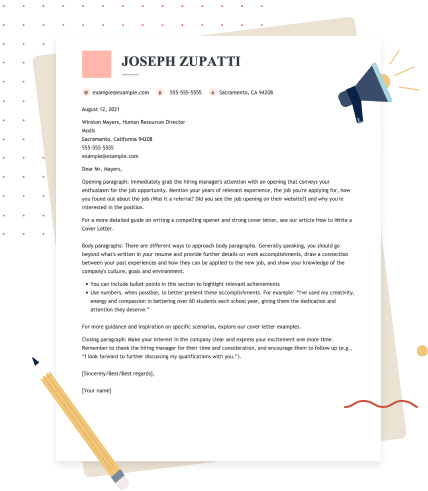How to Write a Letter of Interest: Examples & Guide

Our customers have been hired at: *Foot Note
Sometimes, the best opportunities come from companies you admire—long before they’re actively hiring. That’s where a letter of interest comes in.
Unlike a traditional cover letter that responds to a specific job posting, a letter of interest allows you to introduce yourself, highlight your strengths, and express genuine enthusiasm for working with an organization you respect. It's your proactive pitch—a way to plant a seed before the hiring process even begins.
In this guide, we’ll walk you through how to write a compelling letter of interest and showcase professional examples to help you get inspired.
What Is a Letter of Interest?
A letter of interest, or statement of interest, is a formal way to reach out to a company you'd like to work for, even when no job has been publicly posted.
Instead of waiting for an opening to appear, you're taking the initiative to introduce yourself and express why you'd be a valuable addition to their team. You might write one because you’ve heard about an upcoming role that aligns with your skills, or simply because you admire the company’s mission, culture, or recent work.
Your letter should make a compelling case for how your skills, experience, and expertise can meet the company’s needs, even ones they haven’t realized yet.
The goal is to get on the radar of a hiring manager or recruiter, showcase your most relevant qualifications, and spark a conversation that could lead to an interview.
How to Write a Letter of Interest for a Job
Writing a letter of interest is about making a great first impression. Here’s how to do it step by step:
STEP 1
Research the company
Even if you’re already familiar with the company—which is likely what sparked your interest—your first step in writing a strong letter of interest should be intentional research.
Go beyond the basics. Dive into the company’s:
- Mission
- Values
- Recent projects
- Industry reputation
- Workplace culture
- Products or services
- Recent press releases
- Employee reviews
- Leadership interviews
Knowing what sets the company apart will help you make a compelling case for why you belong there. Show them how your skills align with their goals, how your perspective could enhance their products or services, or how your values reflect theirs.
The more specific and thoughtful your insights, the more convincing your letter will be—and the more likely it is to catch the right person’s attention.
STEP 2
Personalize your letter of interest
When you’re reaching out without a job posting to respond to, being specific and personal matters even more.
Think about your reasons for writing: Are you drawn to a particular team, project, or area of the company? Aim to direct your letter to someone connected to that—whether it’s a department manager, a lead researcher, a product director, or even a senior team member whose work you admire.
Personalizing your letter by addressing it to a real person shows initiative, attention to detail, and genuine interest. It turns your message from a cold introduction into a meaningful, targeted pitch.
STEP 3
Craft a compelling introduction
Start with a strong hook that immediately explains why you’re reaching out.
Mention something specific that genuinely draws you to the company: a standout product, a recent initiative, a compelling mission, or even a campaign that aligns with your values or expertise.
In that same opening paragraph, introduce yourself and briefly highlight your qualifications in a way that directly connects to what you admire about the company. Here’s an example:
STEP 4
Highlight what sets you apart
This is the heart of your elevator pitch—where you go beyond job titles and clearly show what you’ve done, what you’re great at, and your impact.
Instead of simply listing past responsibilities, focus on measurable achievements that demonstrate your value. Back your claims with numbers and percentages to paint a clear picture of your contributions.
See this example:
STEP 5
Demonstrate how you fit into the company culture
Hiring decisions aren’t based on skills alone—they’re also about cultural fit. A strong candidate is someone who not only brings expertise to the table but also aligns with the company’s values, work style, and team dynamics.
Use your research to elevate this part of your letter. Match those insights to your personality, work experience, and leadership style, and explain how you’d fit into and strengthen their environment.
Here’s how that might sound in your letter:
STEP 6
End with a call to action
Close your letter with confidence and purpose. Your ending should invite the reader to take the next step—whether that’s reviewing your attached materials, scheduling a conversation, or simply keeping you in mind for future opportunities. This leaves the door open and hands the initiative back to the employer in a positive way.
Reinforce your enthusiasm and the value you bring by ending with a clear, polite call to action. Here’s an example:
Letter of Interest Sample
See how this job seeker took advantage of her dream company creating a new division to send a letter of interest:
Letter of Interest Template
Need more help? Try using this template:
Dear [Recipient’s Name],
I am writing to express my interest in potential opportunities with [Company Name]. I have long admired your company’s commitment to [specific aspect of the company—mission, product, culture, recent achievement], and I believe my background in [your field/expertise] positions me well to contribute to your team’s continued success.
With over [number] years of experience in [your industry or role], I have developed strong skills in [key skills or areas of expertise]. For example, in my current/previous role at [Current/Previous Employer], I [describe a measurable achievement or key responsibility that relates to the company or role]. I am confident that my ability to [specific skill or strength] would allow me to add value to [Company Name], especially as you [mention a company goal, project, or value relevant to your expertise].
In addition to my technical qualifications, I greatly admire [Company Name]’s focus on [company culture aspect, such as collaboration, innovation, sustainability]. I strive to bring these same principles into my work, whether it’s leading cross-functional teams or driving initiatives that align with core values. I would welcome the opportunity to bring my experience and enthusiasm to your organization.
Please find my resume and portfolio attached for your review. I would be happy to discuss how my background and skills might align with your needs at your convenience. Thank you for considering my letter—I look forward to the possibility of contributing to [Company Name].
Sincerely,
[Your Name]
Formatting Your Letter of Interest
Follow these tips to format your letter of interest effectively:
- Match your header to your resume: Create a header that mirrors your resume, and ensure to include your contact information.
- Pick a professional font: A polished and easily readable font is critical to getting the reader to finish your letter. Opt for fonts like Calibri, Arial, Times New Roman, or Georgia.
- Keep your paragraphs short: Brief and straightforward paragraphs make your letter easy to read. Aim for three to four sentences to keep the reader engaged.
- Use consistent spacing: Use single spacing between paragraphs and standard 1-inch margins on all sides.
- Limit your letter to one page: One page is ideal for delivering your message clearly and respecting the reader’s time.
Letter of Interest vs. Cover Letter: What’s the Difference?
The key difference between a letter of interest and a cover letter lies in when and why they’re sent.
Job seekers write cover letters responding to a job posting to support a formal application for a specific, advertised role. Employers often require it alongside your resume to better understand your fit for that particular position.
See this graphic designer cover letter:
A letter of interest, by contrast, is proactive. It’s sent when there are no active job openings, or when you’re interested in a position that’s not currently being advertised. Think of it as a way to get your foot in the door by introducing yourself, sharing why you’re drawn to the company, and showing how your experience could be an asset to their team, even if they’re not hiring right now.
In this example, the graphic designer is reaching out with a letter of interest:
Both letters use the cover letter format and highlight your professional value. However, a letter of interest emphasizes why you want to work there and how your unique skills or insights could benefit the organization, making a strong case for consideration beyond the typical hiring cycle.
Common Letter of Interest Mistakes to Avoid
What not to do is as important as what to do. Here are some mistakes to be on the lookout for during your writing process and your final review.
- Using generic content: Letters of interest are meant to be highly personal and customized. Using generic content can render your letter null and get it quickly dismissed.
- Being too passive or aggressive: A letter of interest shows intention; you’re taking a step by yourself, unprompted. If the letter itself isn’t assertive enough, it will feel pointless. However, keep it as professional as possible, and don’t push yourself in the conversation in an arrogant manner.
- Not proofreading: Read it more than twice, run it through grammar and spelling software, and share it with a colleague who can provide a fresh pair of eyes.
Key Takeaways
- A letter of interest is a proactive way to reach out to employers when there are no specific job openings available.
- It differs from a cover letter by focusing on general value, not a specific role.
- Key elements include research, personalization, and a strong call to action.
- Format and tone matter—keep it professional, concise, and tailored.
- Avoid generic phrasing, excessive pushiness, and typos.
FAQ
When should I send a letter of interest?
When to send a letter of interest is entirely up to you, since it’s unprompted as opposed to reacting to a job opening. However, there may be strategic moments to send a letter of interest, such as when:
- The company you admire has just achieved a significant milestone, and you believe they’ll want to expand on a particular project or department.
- A company is going through certain issues or changes, and you think you’re particularly equipped to help with them.
- You just graduated or achieved a specific milestone and believe yourself to be more prepared and qualified for a job.
How do I find the right person to address my letter to?
Research the company’s website to see if they have contact information; they’ll likely provide information about the HR department and hiring managers. If you’re looking to address a specific person, look for their professional social media, such as LinkedIn or Bold.pro, to find their information.
You can also ask any colleagues if they’re familiar with the company’s structure, a certain department head, or more.
How long should a letter of interest be?
Preferably, keep a letter of interest to a single page. This ensures that all the relevant information is easily accessible, without any fluff. It also helps encourage hiring managers to read it instead of instantly dismissing it.
Should I attach a resume when sending a letter of interest?
Yes! Attaching your resume with your letter of interest is a crucial step. Make sure to attach a portfolio as well, if your industry requires that type of document. This way, employers have a full picture of who you are and what you’re capable of.
Our customers have been hired at:*Foot Note



